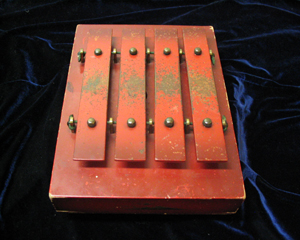the deagan 400 series dinner chime

In the early years of the 20th century, The J. C. Deagan Company made a variety of dinner chimes in configurations of three, four, and five chime plates mounted over wooden resonator boxes. The chimes varied in pitch, and the lower the tone of the chime the thicker the resonator box was. By the 1930s the selection had been pared down considerably; one of the few models left in the catalogue was the 400 Series model.
The 400 Series was originally available in several colors, including Mandarin Red pictured here; by the early 1950s, it was only available in a Birch Mahogany base with Tuscan bronze chime plates. The chime notes, in ascending order, were E♭, A♭, C, and E♭, with the C being an octave above Middle C. The Deagan 400 series dinner chime sold at retail for $9.00.
The 400 series chime was used for local identification for WTMJ Milwaukee in 1931, of which at least one recording still exists, and on the recording of “The Fourth Chime” as heard on D–Day, June 6, 1944. This chime is also known to have been used for the local chime identification of WCSH in Portland, Maine.
There was a five–note variation (the fifth note being A♭ an octave above the second chime plate), known as the Series 500, which sold for $11.00. For those desiring a wooden-resonator chime box but limited to a budget, Deagan also offered the Series 300 chime. The 300 sold for $8.00, and featured the same four chime notes as the 400 series. The chime plates, however, were of varying lengths rather than Deagan’s traditional process of having the chime plates all the same length but of varying thicknesses. This led to a chime tone that was not so rich or resonant as the 400 Series, but was pleasing to the ear just the same.